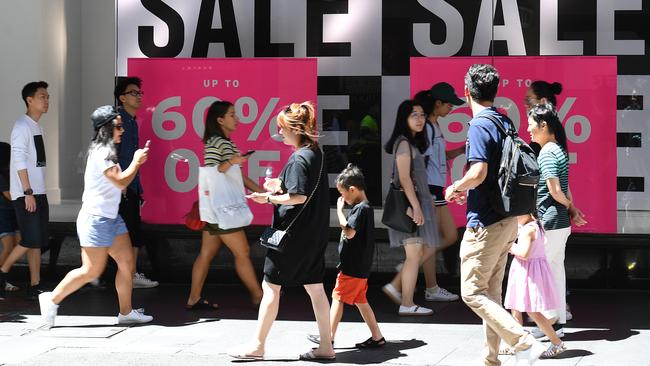Reserve Bank rate cuts fail to fire up retail sales
‘Disappointing’ figures show retail sales have failed to respond to recent interest rate cuts by the Reserve Bank.

Australian retail sales have failed to respond to recent interest rate cuts by the Reserve Bank.
Retail sales growth of just 0.2 per cent month-on-month in October fell short of market expectations it would remain at the moderate 0.4 per cent pace recorded for September.
Rises in “other” retailing, cafes, restaurants and takeaway services and food retailing were slightly offset by a fall in clothing, footwear and personal accessory retailing and department stores, while household good sales were flat.
Perhaps more concerning was a 0.1 per cent quarter-on-quarter fall in the volume of retail sales in the September quarter, versus the June quarter.
READ MORE:
Economy shows signs of life | David Jones chalks up losses | Coles hoping for Christmas growth
Westpac senior economist Matthew Hassan said the report “disappointed in every respect”.
“The monthly profile continues to show little or no response to policy measures – interest rate cuts in June-July and tax relief from July should have added about $3bn to monthly household disposable incomes,” he noted.
“With retail sales running at $27bn a month, even a small flow on impact to spending would quickly turn the dial, but sales have instead posted lacklustre gains.”
He also noted that quarterly real retail sales have declined in three of the last four quarters amid moderating nominal sales growth and stronger price gains, with the bigger impact from prices.
“Annual growth in retail prices surged from 1.1 per cent a year a year ago to 2.7 per cent a year currently – reflecting gains for both food - some relating to the drought - and non-food retail,” said Mr Hassan.
“While some of the rise is undoubtedly cost-driven, there are some indications that retailers have been shoring up weak margins in recent quarters.”
NAB economist Kaixin Owyon said retail volumes have now recorded falls of 0.1 per cent in three of the past four quarters, to be 0.2 per cent lower than year ago.
“By way of comparison, the last time volumes fell on an annual basis was the 0.6 per cent decline seen in the early 1990s recession,” she said.
“These data are a worrying sign that overall consumer spending growth was weak in the September quarter despite support from the $7.2bn of income tax refunds that started flowing from July and the RBA rate cuts in June and July.
“This suggests that the underlying trend for the consumer may have deteriorated, whereas the RBA expects a gradual improvement to support a ‘gentle turning point’ in the economy.”
The Australian dollar fell from US69.16 cents to as low as US69.04 cents immediately after the release of the data, and was worth US69.06c at 11.40am (AEDT).
The quarterly fall in volumes was led by cafes, restaurants and takeaway food services, and department stores.
Food retailing was flat while household goods, other retailing and clothing, footwear and personal accessories retailing rose in seasonally-adjusted volume terms.
The trend estimate for Australian retail turnover rose 0.2 per cent in September 2019 after a rise of 0.2 per cent in August 2019. Compared to September 2018, the trend estimate rose 2.4 per cent.
The data are the latest sign that the potential transmission of interest rate and tax cuts to the economy is being impeded by increased saving, amid high household debt levels.
Capital Economics chief economist Marcel Thieliant said the retail figures showed the RBA has more work to do.
He estimated that around 60 per cent of the tax refunds had arrived in households’ bank accounts by the end of September, leaving another 40 per cent still to arrive in the fourth quarter.
While it was possible that households would only spend the receipts in the fourth quarter, as things stood though, the government’s tax cuts were not providing any boost to consumer spending.
“That supports our view that GDP growth will continue to fall short of potential next year and that the RBA will have to cut interest rates by more than most anticipate,” he said.
The retail figures come after consumer confidence continued to fall in October amid concern about the economic slowdown. Growth fell to just 1.4 per cent for the year to June – the lowest since the GFC.
The RBA has cut official interest rates three times to a record-low 0.75 per cent cash rate since June and the government has eased fiscal policy via greater tax rebates.





To join the conversation, please log in. Don't have an account? Register
Join the conversation, you are commenting as Logout